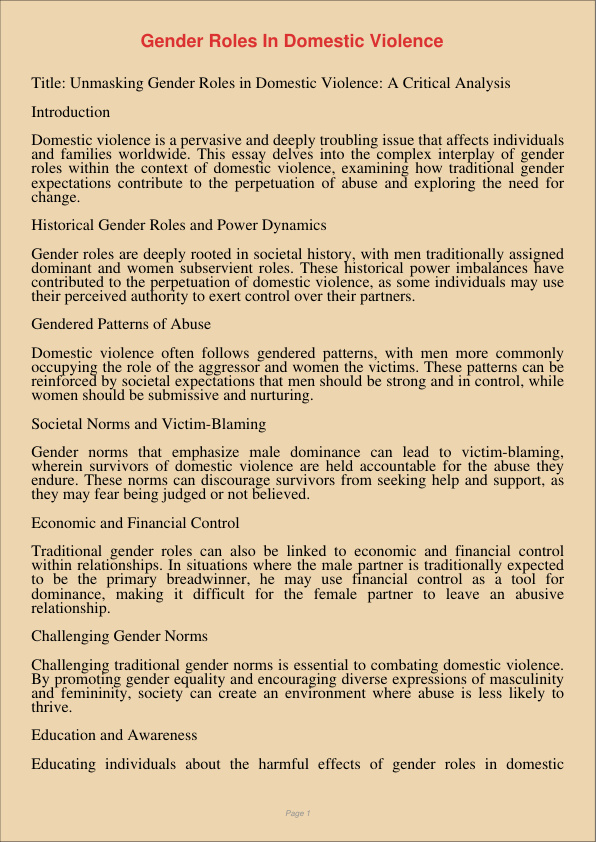Gender Roles In Domestic Violence
Jan 9, 2024
gender roles
domestic violence
Psychology
Health Sciences & Medicine
Title: Unmasking Gender Roles in Domestic Violence: A Critical Analysis
Introduction
Domestic violence is a pervasive and deeply troubling issue that affects individuals and families worldwide. This essay delves into the complex interplay of gender roles within the context of domestic violence, examining how traditional gender expectations contribute to the perpetuation of abuse and exploring the need for change.
Historical Gender Roles and Power Dynamics
Gender roles are deeply rooted in societal history, with men traditionally assigned dominant and women subservient roles. These historical power imbalances have contributed to the perpetuation of domestic violence, as some individuals may use their perceived authority to exert control over their partners.
Gendered Patterns of Abuse
Domestic violence often follows gendered patterns, with men more commonly occupying the role of the aggressor and women the victims. These patterns can be reinforced by societal expectations that men should be strong and in control, while women should be submissive and nurturing.
Societal Norms and Victim-Blaming
Gender norms that emphasize male dominance can lead to victim-blaming, wherein survivors of domestic violence are held accountable for the abuse they endure. These norms can discourage survivors from seeking help and support, as they may fear being judged or not believed.
Economic and Financial Control
Traditional gender roles can also be linked to economic and financial control within relationships. In situations where the male partner is traditionally expected to be the primary breadwinner, he may use financial control as a tool for dominance, making it difficult for the female partner to leave an abusive relationship.
Challenging Gender Norms
Challenging traditional gender norms is essential to combating domestic violence. By promoting gender equality and encouraging diverse expressions of masculinity and femininity, society can create an environment where abuse is less likely to thrive.
Education and Awareness
Educating individuals about the harmful effects of gender roles in domestic violence is crucial. Schools, communities, and organizations can play a role in raising awareness about the destructive impact of traditional gender expectations and the importance of healthy, equal relationships.
Support and Empowerment
Providing support and resources to survivors of domestic violence is vital. Empowering survivors to regain control over their lives and escape abusive relationships is a key component of breaking free from the constraints of traditional gender roles.
Legal and Policy Reforms
Legal and policy reforms can contribute to addressing domestic violence. Laws and regulations that protect survivors, hold abusers accountable, and provide resources for rehabilitation are critical in dismantling the power imbalances associated with traditional gender roles.
Cultural Sensitivity
Recognizing that gender roles and their impact on domestic violence may vary across cultures is important. Approaches to addressing this issue should be sensitive to cultural nuances while still advocating for gender equality and violence prevention.
Conclusion
Domestic violence is a multifaceted issue deeply intertwined with traditional gender roles and expectations. To combat this pervasive problem, society must acknowledge the role of these gender norms in perpetuating abuse and work toward dismantling them. Through education, support, legal reforms, and a commitment to gender equality, we can help survivors break free from the constraints of traditional gender roles and create a world where domestic violence is no longer tolerated. It is only through a collective effort that we can unmask and eradicate the influence of gender roles in domestic violence.
